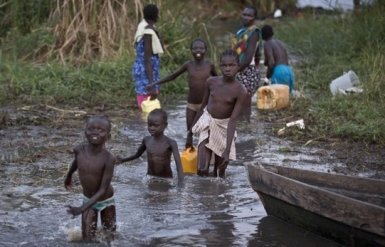Floods displace South Sudan swamp communities
March 15, 2014 (BOR) – Dinka Bor communities who fled to swampy areas in South Sudan’s Jonglei state after violence swept the country in mid-December have been displaced for the second time in three months due to rising floodwaters.

Speaking to Sudan Tribune by phone from Mathiang, one of the chiefs, Gabriel Pandek, said the flooding had exacerbated existing problems linked to poor sanitation and overcrowding.
“Already there was population pressure in the places we lived. Too many people in small areas, sanitation was our initial problem … Now there is [a] flood,” he said.
He said the communities had discussed relocating to Aliap in Lakes state, but most feel secure enough to return to their homes, with government forces in Panyier camp near Pariak offering some protection.
According to Pandek, local youths still intend to move their cattle to Aliap for the rainy season, an area considered safe.
The chief estimates that some 67,000 families live in the Toc area, which stretches along the Nile river from Pariak to near Gemeza town in Central Equatoria state.
Pandek said the area included five cattle camps, adding that people from payams (districts) outside Kolnyang, including non-Dinka communities from Bor, had also been integrated.
NUER WOMEN AND CHILDREN SHELTERED
Prior to the outbreak of violence in South Sudan, a large community of Nuer lived in Pariak of Kolnyang payam in Bor county. Many of these families were headed by disabled soldiers from the South Sudan army (SPLA), while others were doing business in the area.
Pandek says two Nuer women and their six children have been in his care since conflict broke out in the SPLA headquarters of Pan-pandiar and Malual-chat in Bor.
An estimated 20,000 people have been killed and almost one million displaced since violence spread throughout the country, pitting forces loyal to the Salva-Kiir-led government against rebels aligned with former vice-president Riek Machar, who was removed from his position last July.
“These two women are under my protection. Their husbands joined the rebels for fear of their lives, but the women refused to go. What we eat is what they eat. To me, since they trusted me, I don’t see them like enemies but as my own people,” said Pandek.
He said the women were left behind after their husbands left with Colonel Chuol Poch, a former SPLS officer based in Pariak since 2009.
Poch lost one of his legs during the civil war with the north before the signing of the 2005 Comprehensive Peace Agreement (CPA) brought the more than two-decades-long conflict to an end.
The chief said he could not disclose the exact location of the women due to security reasons, but said he had an arrangement with one of the SPLA’s commanding officials in Panyier that had agreed to protect the women against any threat.
Panyier, which is part of Pariak, is one of the places occupied by SPLA soldiers.
Sudan Tribune was unable to speak to the two women to independently verify the claims.
Tuor Ayeun Kur, one of the youth members of the same village headed by chief Pandek, said he had met the women once, but was told sometime later that they had been taken to Juba by boat.
“If they are there, I don’t know where they are, we are here busy guarding the village; I rarely have time to visit the Toc,” said Ayuen.
(ST)
